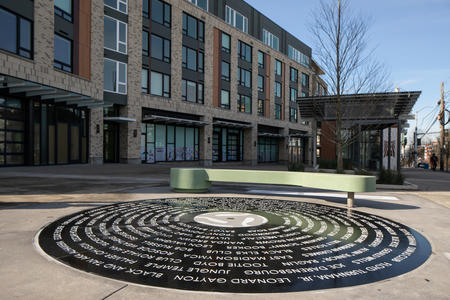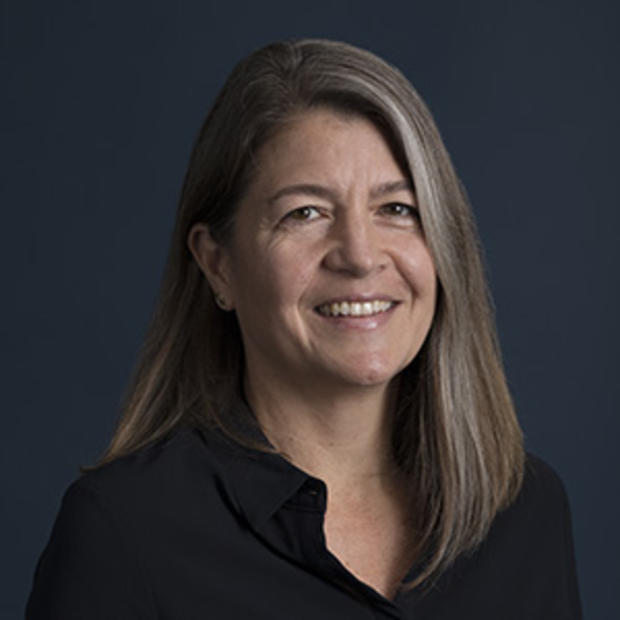“It wasn’t built to move that way,” she told me, when I visited her at the site this week. “It’s made to just sit there.” (As logs often do.) And in this case, where it sits is key: on the ruins of Dickman Lumber Company, Tacoma’s last running waterfront sawmill, established in 1889, closed in 1977 and destroyed by a fire in 1979.
ArtSEA: Notes on Northwest Culture is Crosscut’s weekly arts & culture newsletter.
The massive head saw from that facility survived the fire and was placed on the Washington Heritage Register. Now, the 34-foot-tall, 15-ton artifact has been newly restored and reinstalled at its former home on the shore of Commencement Bay. In Tacoma’s lumber industry heyday (1920s and ’30s) the head saw cut through 150,000 feet of lumber a day.
All those numbers can be hard to grok, so part of Coss’ intention with “Ghost Log” — which sits on the carriage next to the saw, as if about to be sliced — is to help people visualize the incredible scale of these timbers. “The saw could cut logs 10 feet in diameter,” she told me, as the defunct machine loomed over us on the pier. “We don’t have logs like that anymore.”
But from the project’s inception, Coss knew she wanted her piece to serve as something more than historic replica. “I was hired to tell the story of the mill,” she said, “but I wanted to tell the story of the millworkers and the Indigenous population. I set out to explore where the crossover was and how I could tell these dual stories.”
The first thing Coss did was to reach out to the Puyallup Tribe. “There was never a settlement right here,” she said, gesturing at the concrete remnants from the mill, “but pretty close.” She wanted to honor the Indigenous history of the area but also worried about cultural appropriation.
Tribal leaders gave her the go ahead and invited her to join them on a cedar gathering to source boughs for use in basket weaving. Coss was thrilled to incorporate her new understanding of the craft into the design for “Ghost Log.”
With our hard hats secured and given a nod from the installation engineers, Coss and I walked all around the piece, which reveals its many elements from different angles. The texture and color of the weathered metal looks uncannily like bark, especially with Coss’ artful laser cuts. The end closest to the head saw mirrors the industrial look of the saw wheel, but the hollow structure quickly shifts to a cross section of tree rings suggesting its ancient age.
Moving toward the water, the log begins to disintegrate — its bark falls away, and the cylinder morphs into a loosely woven basket. At the very end, individual metal strands are twined in the Puyallup Tribe’s traditional weave. Coss often incorporates text into her sculptures, and here she bent additional metal strands into scripted words for cedar tree, bark, branches and basket in English and Twulshootseed: x̌pay, slagʷac, stidgʷəd, syalt.
When I looked at it from further down the beach, “Ghost Log” started to resemble a giant fish — the cedar boughs providing a tail — that has leapt from the water onto the pier and is heading straight into the saw. I felt an undercurrent of danger in the piece, both for the millworkers who operated the mechanical maw and the land, which would be forever changed by it.
Coss is currently working on another aspect of the installation: “Ghost Timbre,” an audio recording featuring sounds captured at a working sawmill in Oregon, nature sounds from the waterfront site and interviews with the Dickman family, millworkers and Puyallup elders.
“Ghost Log” and the new park structure surrounding it should be open in July, but a walk along Ruston Way already offers a glimpse of its anachronistic presence.
Coss isn’t the only Seattle artist returning enormous trees to the Northwest landscape. Sculptor John Grade (the Lorax of local installation art), is creating another of his giant tree sculptures — for the North Satellite Terminal at the Seattle-Tacoma International Airport. Similar to his “Middle Fork,” the Western hemlock replica that levitates over the lobby at Seattle Art Museum, “Boundary” is made from a gazillion pieces of salvaged cedar wood.
But instead of branching patterns, “Boundary” emphasizes the remarkable root systems of old-growth Western red cedars, which travelers will be able to marvel at from underneath. Grade tells me he and his team are currently “in the home stretch” of the project. When completed, the piece will be 43 feet high, 80 feet wide and 20 feet deep. Yet another reason to look forward to post-vaccinated air travel.
And if you can’t get enough of big tree sculptures (see also: Grade’s towering “Wawona” in the MOHAI atrium!), head to the University of Washington campus and find “Stronghold,” by artist Brian Tolle. It’s not as large as Coss or Grade’s pieces, but I love the way the oversized stump (20 feet in diameter, made of stacked and shaped cedar planks) immediately imparts the enormousness of the forests that stretched across the land before logging became the industry that literally built the Northwest.
Get the latest in local arts and culture
This weekly newsletter brings arts news and cultural events straight to your inbox.









